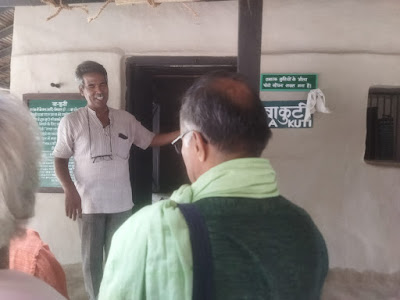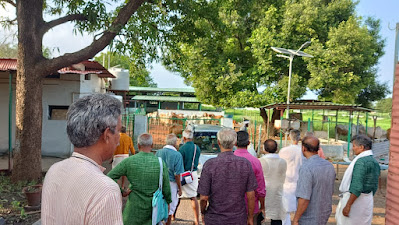Orientation Programme/Study Course on Understanding Gandhi
SEVAGRAM ASHRAM
PRATISHTHAN
in association with
GANDHIAN COLLECTIVE
KERALA
ORIENTATION PROGRAMME /STUDY COURSE FOR SOCIAL ACTIVISTS
UNDERSTANDING GANDHI
Sevagram Ashram Pratishthan in association with Gandhian Collective Kerala organized an orientation programme/ Study Course for social activists from 22 to 26 July 2023. Gandhian Collective Kerala is a part of national network Gandhian Collective India. The objective of the programme was to understand the philosophy and message of Gandhi by visiting historical places connected with Mahama Gandhi in Wardha and experiencing vibes of the place. In addition it aimed at analyzing Gandhi’s ideas in the contemporary context. The participants of the programme assembled at Sabari Ashram at Akkathethara in Palakkad district of Kerala. The programme was started on July 22, 2023 by lighting the traditional lamp at the room where Gandhi stayed during his visits to Sabari ashram.
On the second day the programme started with an
explorative guided visit to the Sevagram Ashram. The significance of each place was explained to them , starting from the area where Gandhi lived in a makeshift arrangement when came to Segaon on April 30, 1936 to the last residence when he left the ashram on 25 th August 1946. In addition to the heritage buildings in the ashram, a brief history of Gandhi’s basic education and the premises where the educational experiment was held were explained to them. A special visit to the Cotton to Cloth workshop of the Ashram where Khadi is produced was also arranged. It helped them to understand the significance of the Ashram and its contribution in the freedom struggle and constructive action.
In the afternoon, the participants assembled at the Seminar hall of Library and Research Centre of the Ashram. They welcomed the three cyclists who came from Kerala with the message "Lesser Carbon, Greener the world." Shri Sunny Paikada introduced them to the participants. Their final destination is Kashmir. Three of them shared their experiences of their cycle ride through different States. Dr. Siby K. Joseph honoured them and prominent Malayalam writer Shri Madhavan Puracheri, extended warm greetings to them and the group congratulated them for undertaking this mission. It was followed by a presentation by Shri Abdul Nazeer an air force veteran currently working in the State Bank of India as a Deputy Manager. He focused on the necessity of reducing our wants in order to avoid an ecological disaster. We should use the resources to the bare minimum. Even in this Seminar Hall we should restrict the use of electricity only to the place we are currently utilizing. In this manner, we can contribute towards reducing Carbon footprint through these simple gestures. We have to move from an economy of wants to an economy of needs. This was the idea Mahatma Gandhi placed before us and it is extremely important when the whole world is experiencing after effects of climate change. The present day economy is an economy of greed which demands maximum exploitation of resources. What is needed is minimalisation. Commenting on the presentation Dr. Siby K. Joseph stated that it can be described as a ‘green economy.’
The next session was basically a sharing session. The participants explained Gandhi in their lives and their involvement in social action. They also explained the reason for joining this orientation programme at Sevagram Ashram. It was a great experience to know each other and their area of expertise. All of them shared their experiences with utmost sincerity and the heterogeneous nature of the group makes it a very lively forum for exchange of ideas.
Evening prayer at the Ashram
The discussion centred on this theme continued in the next session which commenced soon after the evening prayer at the ashram. A family feeling was created and the elders, youngsters and a few children in the group enthusiastically shared their feelings without any inhibitions.
Taking note of the limited time at the disposal of participants and the interest of the group, post dinner sessions were also organized. In the post dinner session, a power point presentation titled “Source of Joy” Shri Sushil Kumar Gotla’s artistic journey into Gandhi was presented. The second presentation was on Ashrams of Gandhi in India and South Africa followed by life and message of Sevagram Ashram.
After early morning prayer at the Ashram
On the third day the participants attended the early morning prayer at 4.45 am. The morning prayer at the ashram was an unforgettable experience in their life. The participants were filled with lot of enthusiasm and spirit. They poured all their energy in Shramdhan/physical work in the morning.
After breakfast a session was held at the Seminar hall of the Library and Research Centre of the Ashram. The keynote speaker was Shri Madhavan Puracheri, a poet and writer. The main theme of his presentation was the dialogues of Gandhiji. He explained how Gandhi engaged in dialogues with personalities who were withholding diametrically opposite views. He engaged in constant dialogue with a long line of popular leaders like of those days PC Joshi, Ambedkar, Lohia, et al. He succinctly explained the significance of dialogue in a democratic polity and lamented that such dialogues are missing in present day India. Gandhi realized that power is a form of evil. Gandhi firmly believed that freedom can be exercised only through the defense of the individual against the State.
After this session, the participants visited Gandhian and constructive organizations in Wardha. The group visited Charkha Griha of Sevagram Ashram, Gram Seva Mandal, Japanese Buddhist temple and Peace Pagoda, Jamnalal Bajaj and Vinoba Exhibition and Gitai Mandir at Gopuri , Magan Sangrahalaya exhibition founded by Mahatma Gandhi at Wardha.
Final destination was Brahma Vidya Mandir of Acharya Vinoba Bhave at Paunar. They also had an interactive session with Shri Gautam Bajaj of the Paunar Ashram. He shared his experiences in Kerala with Acharya Vinoba Bhave during the Bhoodan movement.The brief talk and interaction was highly appreciated by all.They also paid tributes to Mahatma Gandhi and Vinoba at the place of immersion of their ashes at Dham river.
After dinner, the participants assembled at Yatri Niwas Seminar Hall. It was devoted to expressing the talents of the participants before the group. A brief presentation on certain learning gained as a martial art trainer was placed before the group by Shri Naveen. It was followed by cultural performances of talented persons in the group.
On the fourth day participants see off the cyclists after the early morning prayer at the ashram. After community work and breakfast the participants visited the Sevagram village where Dr. B. R. Ambedkar addressed the villagers after the meeting with Mahatma Gandhi in May 1936. The participants on seeing the memorial rock where Dr. Ambedkar sat to address the villagers filled with grass and weeds, immediately swung into action and cleaned the area. The historical importance of the place was explained to them. They also visited the Buddha Vihar in the compound and offered prayers.
The participants returned from the village and soon assembled at Seminar hall of the Library and Research Centre. Adv. Banjamin Paul, a veteran Gandhian, began the discussion on what is conspicuous in the portraits of Mahatma Gandhi placed in the new Seminar hall. The participants pointed out long ears, forehead, face and lips and so on. Shri Pramod was of the opinion that the legs of Gandhi are unique ( that was not depicted in the portraits) which enabled him to walk all around the country and awakened the people. Adv. Bajamin Paul opined that what appears to him is nothing but long ears. Gandhi was a patient listener always ready to listen to each and everyone. As a medical practitioner, Dr. Bharatan A V was not ready to accept this interpretation. It was pointed out that it is totality of everything made Gandhi a unique personality.
After this sharing , Shri Sunny Paikada made a brief presentation on key concerns of the Gandhian Collective and how it was formed at the national level. He pinpointed "The Time Demands Gandhi" Campaign of Gandhian Collective at the regional and National level. He discussed its significance in the context of Climate Change, Corporate Raj and Divisive Politics.The next session was devoted to the practical action that can be taken up at the Individual and collective level. All the participants shared their views and some sort of consensus was arrived on the key areas of action that can be taken up at the individual and collective level.
In the afternoon documentary viz. MAHATMA - Life of Gandhi, 1869-1948 was screened. The screening of the documentary continued after the evening prayer. The participants watched it rapt attention an was really moved .
The valedictory session was held at the Yatri Niwas hall after dinner. In the valedictory session, the participants evaluated the days they spent at the Sevagram. Certificates of appreciation were issued to all participants. The participants were full of appreciation of the study course and provided constructive suggestions. It was decided to organise online meet once in a month and follow-up gathering meets to keep the bond of relationship developed during the programme and to asses the implementation of ideas discussed here. On the fifth day early morning the participants departed from the premises of the Ashram with much cherished memories.



























.jpg)


.jpg)
.jpg)











.jpg)




















.jpg)



Comments
Post a Comment